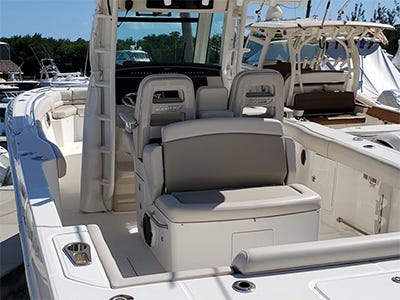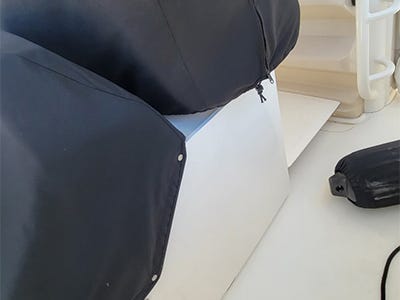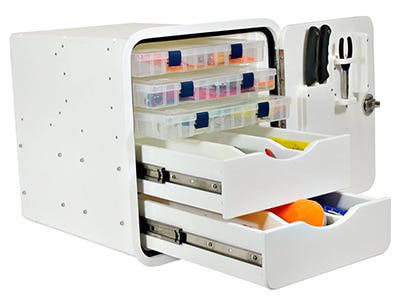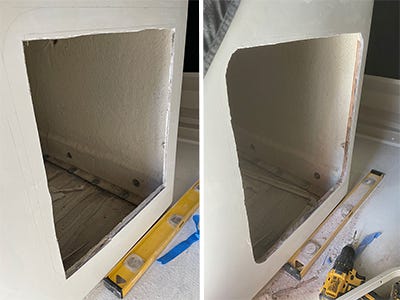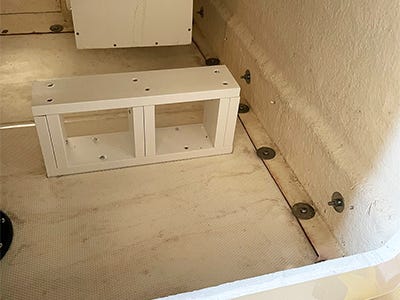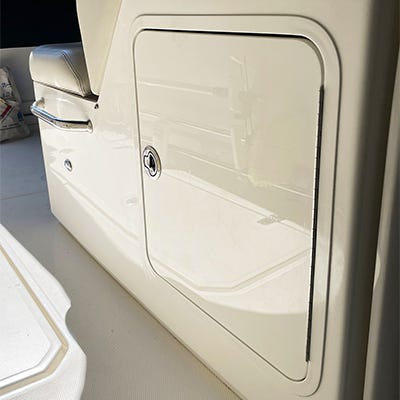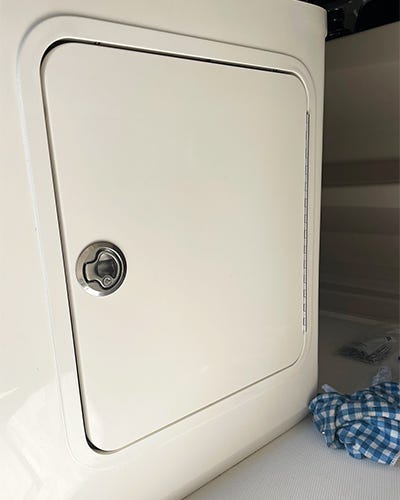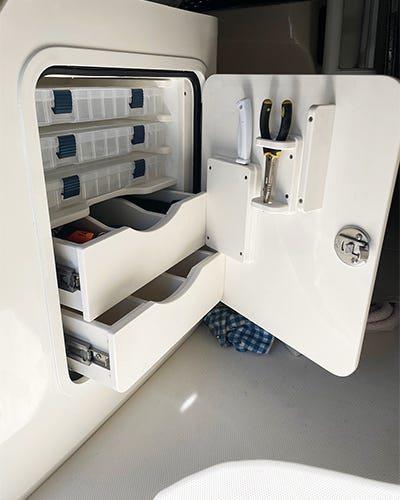

If there was one thing Joe Capalbo missed about his previous boat, it was the recessed tackle storage units in both sides of the leaning post, readily accessible from the cockpit. It wasn’t that his new boat, a 2020 Boston Whaler Outrage 330, didn’t have plenty of room for fishing gear. It was just that most of that room was inside the step-down console — not where you want to be in the middle of striper blitz.
Need for More Tackle Storage
The port side of the Outrage’s leaning post featured a convenient three-drawer storage unit, but it just wasn’t big enough for Capalbo’s fishing style.
He needed more room to store jigs, poppers, weights, hooks, leader, knives, pliers, gloves, fish towels, rod leashes, and more within arm’s reach of the cockpit while fishing his Chesapeake Bay home waters.
An Obvious Spot
The obvious spot was the starboard side of the big fiberglass leaning post. Whaler offers an optional pullout refrigerator on the Outrage 330 that mounts in that location, but Capalbo’s boat wasn’t equipped with one, leaving a “blank” fiberglass panel.
Capalbo temporarily removed a speaker from the port side of the leaning post so he could see inside and confirmed there was nothing behind the panel except empty space.
The Goldilocks of Tackle Boxes
Now it was just a matter of finding a tackle storage unit the right size, which turned out to be tougher than Capalbo expected. There were plenty that would fit easily, of course, but he wanted to leave no wasted space on the table.
Eventually, after combing the web fruitlessly, Capalbo called Boat Outfitters, ready to have a custom box designed and made if that was what it took.
Customer service representative Jason Strub found a pre-designed unit in Boat Outfitters’ catalog that looked like just the right fit.
To his surprise, though, customer service representative Jason Strub found a pre-designed unit in Boat Outfitters’ catalog that looked like just the right fit — the 18” by 20” 2 Drawer, 3 Tray Tackle Center. “It was the perfect height, perfect width, perfect depth,” Capalbo says, “like the Goldilocks of tackle boxes for that location.”
As an added bonus, the door and frame of the tackle unit were a perfect match visually for those of a battery switch box under the gunwale nearby. It turns out Boat Outfitters’ parent company, Teak Isle, had manufactured that box and supplied it to Whaler as original equipment. Both boxes use a low-profile, powder-coated aluminum frame, as opposed to a Starboard frame. The aluminum frame protrudes just 1/8” proud of the mounting panel and also hides all fasteners, for a seamless look.
The Installation Process
When the unit arrived, Capalbo, a former aircraft mechanic, followed instructions as meticulously as you’d expect, first tracing the outside shape of the frame on the mounting panel and then drawing the shape of his cutout 1/2” inside that.
He masked the fiberglass around his cut lines and made an initial rectangular cutout, then carefully expanded the cutout and radiused the corners.
With the cutout completed, Capalbo check the fit of the unit. In order to mount the optional refrigerator if ordered, Boston Whaler had added a layer of 1/2” marine plywood reinforcement behind the fiberglass of the leaning post, which also proved beneficial for mounting the tackle cabinet unit. In order to protect the ply from water intrusion, Capalbo coated all exposed edges of the cutout with epoxy. “I come from the school of ‘You can’t pull over at 35,000 feet,’” Capalbo says. “I’m very particular.”
Adding Additonal Support
Next, Capalbo fabricated a support for the back of the unit. Boat Outfitters recommends that all inset units weighing more than 15 lbs. loaded be supported at the back to take some of the load off the frame screws.
He used King Starboard to build a lightweight but sturdy support block and then attached the block to the deck with self-tapping screws and 5200 marine sealant.
Finishing the Install
That left nothing but drilling pilot holes for the frame screws and installing them.
The plywood reinforcement behind the fiberglass made it easy, providing plenty of “meat” for the screws to bite into. (Installing aluminum-framed storage units, hatches, and doors in panels less than 1/2” thick requires extra steps.)
Capalbo applied a bead of marine sealant behind the unit’s frame, squeezed some into the pilot holes, and finalized the installation.
Aluminum-framed vs. Starboard-framed Storage Units
Capalbo likes the clean, “factory” look of the aluminum-framed tackle unit but does warn that installation is more demanding than with Starboard-framed units. Most of Boat Outfitter’s Starboard-framed boxes, doors and hatches require only a rectangular cutout, rather than a cutout with rounded corners cut to a specific radius. That alone reduces the potential for error significantly.
Additionally, the hidden fasteners on aluminum-framed parts screw into the cut edges of the mounting panel, rather than through the panel from outside to inside. That requires at least 1/2” thick panel. Thinner panels must be built up on the back with strips of Starboard or wood, adding additional steps to the installation. The fastener arrangement also requires care to drill pilot holes parallel with the panel; if holes are drilled at too much of an angle, they can “pop out” through the inside or outside of the panel.
For Capalbo, the perfect match to the OEM access doors elsewhere on his boat is more than worth the more involved installation.
For Capalbo, the perfect match to the OEM access doors elsewhere on his boat is more than worth the more involved installation. Even better than the appearance, though, is the utility of the new tackle box. Fishing for striped bass, Spanish mackerel and cobia throughout the middle Chesapeake Bay and making occasional summer trips to Cape May via the Chesapeake & Delaware Canal to fish offshore for a few days, he still has plenty of room for tackle. “The big stuff like umbrella rigs obviously doesn’t fit in there,” he says,” but pretty much everything else I need during the day does.”

